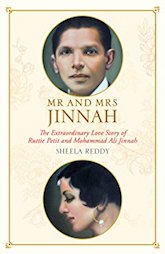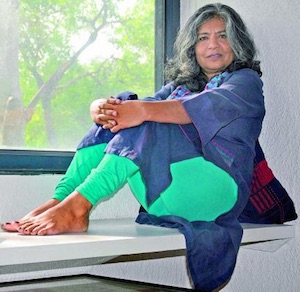Mr. and Mrs. Jinnah: The Marriage that Shook India
Sheela Reddy
|
|
There are probably as many books written on Mohammad Ali Jinnah as on his arch-rival Gandhi, and this is hardly surprising considering that these two fellow Gujaratis, only a few years apart in age, changed the course of the subcontinent’s history and the fate of millions of its inhabitants as no two individuals before or after them has ever done. And yet, Jinnah’s private life, fascinating though it is in all its drama and tortured love and human complexity, remains an enigma, even now, nearly seventy years after his death whereas there is no aspect of Gandhi’s life, however personal or private, that has not received the attention of his biographers and historians.
Why do historians and his biographers invariably have so little to say about his personal life and marriage, even though he was so different from the cold and reserved personality that he habitually put out, a lonely, tortured soul whose shadow determined his politics leading up to the Partition. I didn’t get it until I was well into the project, having determined with what now seems an astoundingly foolish ambition to delve into the man’s mind and heart and try and make sense of his life and the role in it of his marriage at the age of forty-two to a stunningly beautiful Parsi aristocrat, twenty four years younger than him, who fell madly in love with him. It was easy to see why historians had steered cautiously away: there was far too little to go by. Surprisingly for a marriage that was much talked about, took place in the heart of Bombay and became a scandal all over the country, was taken to court and caused so much fury and agitation, especially among the Parsis, leading to a Parsi version of a fatwa against the couple, and was followed by a Muslim vs Parsi newspaper controversy, there are hardly any authentic details available, with almost nothing written by his contemporaries until long after both Jinnah and his wife, Ruttie, had died, and that too only passing references in other people’s autobiographies, fading memories of what was once a seminal event, basing their stories on what they had heard from others, or from their own prejudiced point of view. It is these small snippets of gossip, probably true — of Jinnah going up to his prospective father-in-law and as a preliminary to asking for her hand, interrogating him on his views about inter-communal marriages; of her eloping from her father’s palatial home with an umbrella tucked under her arm; or Jinnah standing up for his wife when she was snubbed by the governor’s wife for her scanty attire — that have been endlessly recycled in Jinnah’s many biographies, leaving so much unexplained. If, for instance, he was such a “cold logician” and frigidly reserved, why did he risk going to gaol and even his political career by insisting on marrying a non-Muslim woman against her father’s wishes? And if he was so sorely tired of her high society ways and her need to shock his conservative constituency, why did he keep holding on to her and never leave her side, “two sweethearts”, as one Parsi friend of theirs put it. And even after they separated, why did he fly to her sickbed in Paris, staying in the hospital and nursing her, literally snatching her from the jaws of death, and ignoring the political crisis that arose in India because of his long absence. It made no sense at all. To add to the mystery, all the letters between them — and there must have been scores of them, considering the long periods they spent apart, both from the two to three years of their courtship and from the ten years of their marriage before she died. Jinnah, of course, was notorious for his aversion to letter writing but Ruttie loved writing letters, long and racy letters written with fountain pen, a recent invention then, on special paper custom-made for her with her initials, and he was not the sort to throw away anything, least of all her letters. But all of them have mysteriously disappeared, not a trace to be found even in the national archives of Pakistan where there is only one letter preserved. And this is a tender letter of farewell from Ruttie, full of tenderness but inexplicable in its reproach and a touching lament for the love they once had, begging him to think of her as “the flower he had plucked” and not what he had trod upon. How was one to investigate, with the letters gone and these two resolutely taking their secrets to the grave with them, what had gone wrong between them, and why. I nearly gave up. And then one day, idling in the Nehru library archives, I came across a whole cache of Ruttie’s letters. They had been lying there all the time, but no researcher or historian had ever bothered to check them out. I think I was the second person since the file was made at the inception of the archives who asked to look at it. It was an exciting moment. There was a whole sheaf of letters from Ruttie, around a hundred pages in all, some of them written from her father’s castle, Petit Hall, and their monsoon retreat, Eagle’s Nest, in Poona, or their so-called cottage which was really an imposing mansion in the hill station of Mahabaleshwar. There were others from ‘South Court’, which was the old name for the Jinnahs’ modest residence on Malabar Hill before he razed it down and built his imposing villa, years after Ruttie had died — his Taj Mahal in her memory. I had Padmaja Naidu — Sarojini Naidu’s elder daughter — to thank for this treasure trove. Padmaja, a close friend of Nehru’s and his daughter, Indira Gandhi, spent her last years actually living in an annexe behind the Nehru Memorial and Museum Library while she set up the archives, contributing the massive correspondence of the Naidu family and their wide network of friends and acquaintances as a start. And Ruttie Petit had been her close friend and correspondent long before she married Jinnah. The letters, dating back to when the two friends were fifteen and ending abruptly a year before Ruttie’s death, when Padmaja was ill with TB and had to move to a sanatorium, were wonderfully vivid, revealing the warm, spontaneous, witty person Ruttie was, with her passion for beauty, dogs, cats, horses, poetry, Paris and politics, and her fond exasperation with “J”, as she called her workaholic, middle-aged husband, and her differences with his sister, Fatima. Jinnah, however, continued to elude me, even though there was no dearth of letters from him to his acquaintances and colleagues at the Bar and in politics. Unsurprisingly, they were all dry, short and business-like, letters of a man who had no time or patience with small talk. They yielded nothing, blocking all doors to the inner him. Even by the standards of his too proper and formal Victorian contemporaries, Jinnah was the most unself-revelatory subject I could have picked to write on. It took a trip to Karachi, the city where he was born and returned to die, to bring me nearer to the Jinnah walled up behind his stony fortressed walls. Most Pakistanis I met seemed to assume that there was nothing of the personal Jinnah to be found in Pakistan. He had presumably left his heart along with his personal life behind in Bombay, where his wife was buried. But here, in the university library, locked up in a special hall in the basement dedicated to him, I found what I was looking for, in the books that he had carried away from his Bombay home. Jinnah had a reputation for reading nothing but newspapers, but here was a library that would have done any well-read gentleman proud. And hidden in the pages of these now antique volumes, in tiny notes and lines, was a different Jinnah, confiding his thoughts and feelings by means of a blue pencil underlining sentences that resonated for him. These margin notations in his books, acquired and read when he was a student in London and later, during the troubled years which coincided with his marriage, had somehow escaped Pakistani historians, hungry though they have been to uncover the man behind the politician, afraid perhaps to face the human Sheela Reddy | Feb 12, 2017 | Mumbai Mirror
|


 Sheela Reddy
Sheela Reddy